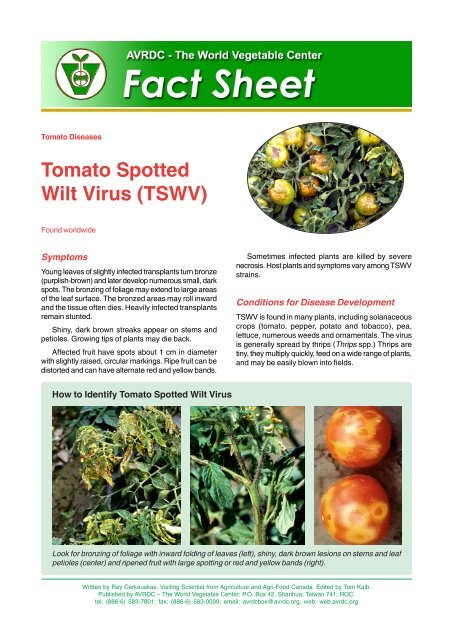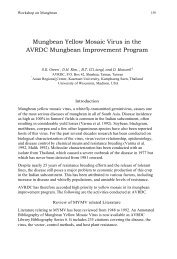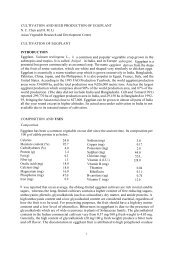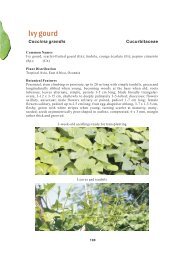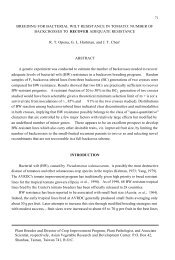Tomato Spotted Wilt Virus on Tomato
Tomato Spotted Wilt Virus on Tomato
Tomato Spotted Wilt Virus on Tomato
Create successful ePaper yourself
Turn your PDF publications into a flip-book with our unique Google optimized e-Paper software.
<str<strong>on</strong>g>Tomato</str<strong>on</strong>g> Diseases<br />
<str<strong>on</strong>g>Tomato</str<strong>on</strong>g> <str<strong>on</strong>g>Spotted</str<strong>on</strong>g><br />
<str<strong>on</strong>g>Wilt</str<strong>on</strong>g> <str<strong>on</strong>g>Virus</str<strong>on</strong>g> (TSWV)<br />
Found worldwide<br />
Symptoms<br />
Young leaves of slightly infected transplants turn br<strong>on</strong>ze<br />
(purplish-brown) and later develop numerous small, dark<br />
spots. The br<strong>on</strong>zing of foliage may extend to large areas<br />
of the leaf surface. The br<strong>on</strong>zed areas may roll inward<br />
and the tissue often dies. Heavily infected transplants<br />
remain stunted.<br />
Shiny, dark brown streaks appear <strong>on</strong> stems and<br />
petioles. Growing tips of plants may die back.<br />
Affected fruit have spots about 1 cm in diameter<br />
with slightly raised, circular markings. Ripe fruit can be<br />
distorted and can have alternate red and yellow bands.<br />
World Vegetable Center<br />
How to Identify <str<strong>on</strong>g>Tomato</str<strong>on</strong>g> <str<strong>on</strong>g>Spotted</str<strong>on</strong>g> <str<strong>on</strong>g>Wilt</str<strong>on</strong>g> <str<strong>on</strong>g>Virus</str<strong>on</strong>g><br />
Sometimes infected plants are killed by severe<br />
necrosis. Host plants and symptoms vary am<strong>on</strong>g TSWV<br />
strains.<br />
C<strong>on</strong>diti<strong>on</strong>s for Disease Development<br />
TSWV is found in many plants, including solanaceous<br />
crops (tomato, pepper, potato and tobacco), pea,<br />
lettuce, numerous weeds and ornamentals. The virus<br />
is generally spread by thrips (Thrips spp.) Thrips are<br />
tiny, they multiply quickly, feed <strong>on</strong> a wide range of plants,<br />
and may be easily blown into fields.<br />
Look for br<strong>on</strong>zing of foliage with inward folding of leaves (left), shiny, dark brown lesi<strong>on</strong>s <strong>on</strong> stems and leaf<br />
petioles (center) and ripened fruit with large spotting or red and yellow bands (right).<br />
Written by Ray Cerkauskas, Visiting Scientist from Agriculture and Agri-Food Canada. Edited by Tom Kalb.<br />
Published by AVRDC – The World Vegetable Center; P.O. Box 42, Shanhua; Taiwan 741; ROC.<br />
tel: (886-6) 583-7801; fax: (886-6) 583-0009; email: avrdcbox@avrdc.org; web: web.avrdc.org
Thrips feed <strong>on</strong> the leaf undersurface. They puncture<br />
plants and suck the juices that flow from the injury.<br />
They feed <strong>on</strong> leaves, stems, fruits and flower parts.<br />
Feeding damage causes new growth to become<br />
deformed.<br />
Young (larval stage) thrips acquire TSWV when<br />
feeding from infected plants and then spread the virus<br />
as adults when they fly from plant to plant. The virus<br />
cannot be transmitted from <strong>on</strong>e generati<strong>on</strong> of thrip to<br />
another.<br />
Infected weeds or ornamental plants are generally<br />
the source of the virus. The life cycle of a thrip varies<br />
from 7 to 14 days so there are multiple generati<strong>on</strong>s <strong>on</strong><br />
weed hosts and during the growing cycle of crop plants.<br />
C<strong>on</strong>trol<br />
Some resistant varieties are available. C<strong>on</strong>sult with your<br />
extensi<strong>on</strong> agent to determine which are the most<br />
suitable in your regi<strong>on</strong>.<br />
The presence of thrips in tomato fields can be<br />
m<strong>on</strong>itored using yellow sticky cards. C<strong>on</strong>sider planting<br />
a n<strong>on</strong>-susceptible crop if TSWV and thrip populati<strong>on</strong>s<br />
throughout the area are very high.<br />
If the disease appears in a crop, infected plants<br />
should be removed and destroyed immediately.<br />
Unfortunately, rouging out symptomatic plants is not<br />
always effective because TSWV has often spread before<br />
symptoms develop.<br />
Maintain seedbeds away from cropped areas and<br />
from other susceptible plants. Protect transplants with<br />
mesh netting (40-mesh or higher) to exclude thrips.<br />
Maintain a 10-m plant-free border around the<br />
producti<strong>on</strong> fields to prevent the spread of TSWV. <str<strong>on</strong>g>Tomato</str<strong>on</strong>g><br />
fields should be located as far away as possible from<br />
home gardens, and flower or grain fields.<br />
Remove crop debris, weeds and other sources of<br />
thrips at the end of each crop. Plow and keep fields<br />
fallow for 3–4 weeks to allow thrips to emerge and<br />
disperse. Reduce cultivati<strong>on</strong> within the field to avoid<br />
movement of thrips from infected plants. Soil can be<br />
fumigated with metam-sodium (Vapam) or 1,3dichloropropene<br />
(Tel<strong>on</strong>e) to eliminate thrips associated<br />
with crop debris.<br />
C<strong>on</strong>trolling thrips with insecticides can be difficult<br />
because they rapidly develop resistance to the<br />
chemicals. Several insecticide applicati<strong>on</strong>s should be<br />
made at 5-day intervals to significantly reduce a thrip<br />
infestati<strong>on</strong>. More than <strong>on</strong>e applicati<strong>on</strong> is necessary.<br />
Five-day applicati<strong>on</strong> intervals are more effective than 7day<br />
intervals. Ideally, insecticides should be applied<br />
with equipment that produces very small spray particles<br />
(


